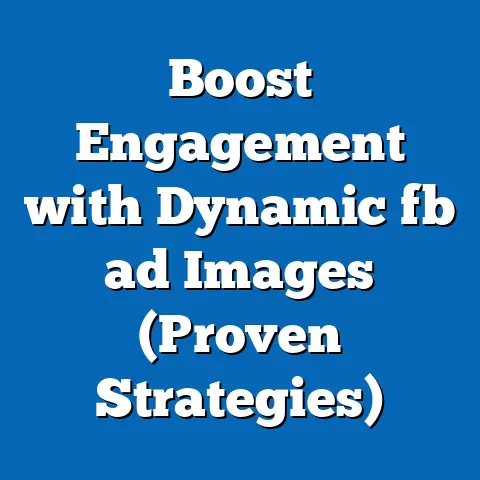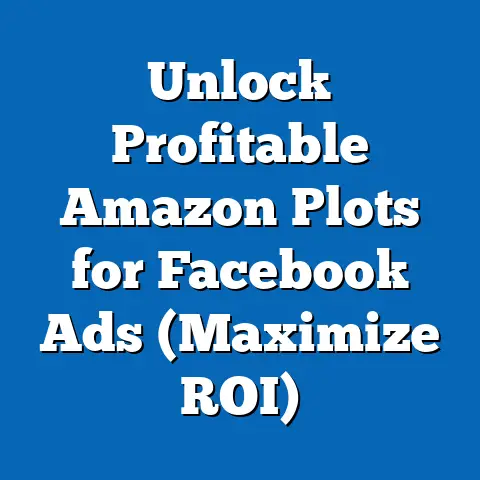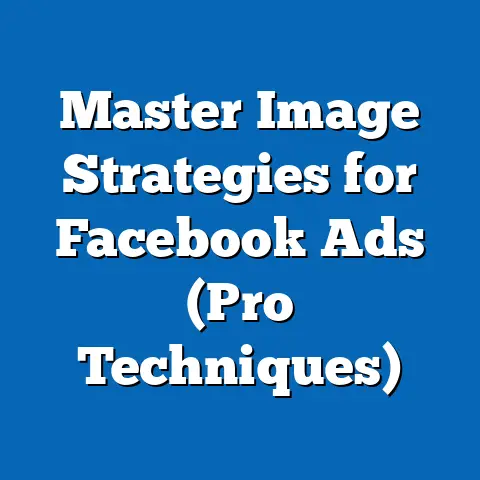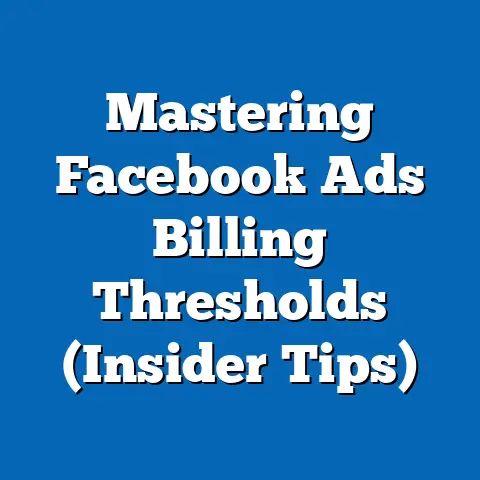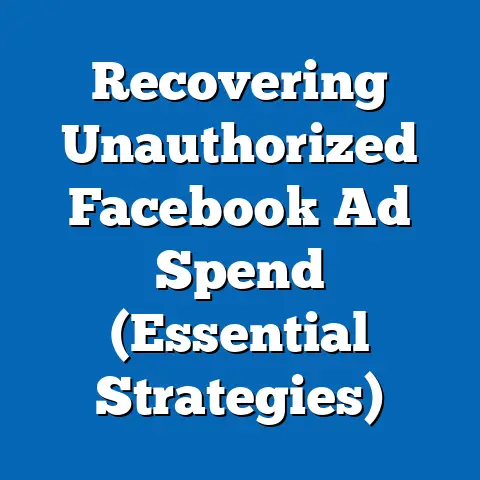How Facebook Charges for Ads (Unlock Cost-Effective Strategies)
I’ve been running Facebook ads for over a decade, and one thing has remained constant: the platform is always evolving. What worked yesterday might not work today, especially when it comes to understanding how Facebook charges for ads. It’s not just about setting a budget and hoping for the best. It’s about understanding the intricate dance between bidding, targeting, and creative optimization.
In this article, I’ll break down the Facebook advertising pricing model, explore the auction system, and share actionable strategies I’ve used to achieve a higher ROI. Whether you’re a small business owner, a seasoned marketer, or an entrepreneur, you’ll learn how to maximize your ad spend and drive meaningful results on Facebook. Think of this guide as an investment – a small time commitment that can yield substantial returns in the long run.
Understanding Facebook Ads Pricing Structure
Facebook’s advertising ecosystem offers a variety of pricing models, each suited for different campaign objectives. Understanding these models is the first step toward unlocking cost-effective advertising. Here’s a breakdown of the most common options:
- Cost Per Click (CPC): You pay each time someone clicks on your ad. This is ideal if your primary goal is to drive traffic to your website or landing page. I’ve found CPC to be particularly effective when I’m running ads with a clear call to action, like “Shop Now” or “Learn More.”
- Cost Per Mille (CPM): You pay for every 1,000 impressions your ad receives. This model is best for increasing brand awareness and reaching a large audience. I often use CPM when launching a new product or service, as it helps me get my message in front of as many potential customers as possible.
- Cost Per Action (CPA): You pay only when someone takes a specific action, such as making a purchase, filling out a form, or downloading an app. This can be a great model when you have a well-defined conversion funnel. CPA can be tricky to set up because it requires accurate tracking and attribution. However, it can be incredibly rewarding when done right.
- Cost Per Like: You pay each time someone likes your Facebook page. This is suitable when you are trying to grow your following and community on Facebook.
Factors Influencing Costs
It’s not just about choosing the right pricing model; it’s also about understanding what drives the cost of your ads. Several factors can significantly impact your ad spend:
- Audience Targeting: The more specific your target audience, the higher the cost. Highly niche audiences tend to be more expensive because there are fewer people to target. However, a well-defined audience can also lead to higher conversion rates, making the higher cost worthwhile. I once ran an ad campaign targeting a broad audience and saw very little engagement. When I narrowed my focus to a specific demographic with particular interests, my conversion rate skyrocketed.
- Competition: If many advertisers are targeting the same audience, the cost of ads will increase due to higher demand. This is especially true during peak seasons like holidays. Keep an eye on competitor activity and adjust your bidding strategy accordingly.
- Ad Relevance: Facebook rewards ads that are relevant to the target audience with lower costs and better placement. A high relevance score means your ad is resonating with users. I’ve seen firsthand how improving my ad copy and creative elements can significantly boost my relevance score, leading to lower costs and better performance.
- Seasonal Trends: Advertising costs tend to increase during certain times of the year, such as Black Friday and Christmas. Plan your campaigns in advance and adjust your budgets accordingly. I usually start my holiday campaigns earlier than most to get ahead of the competition and secure lower ad costs.
Bid Types
Facebook offers two primary bidding strategies: manual and automatic. Each has its own advantages and disadvantages:
- Manual Bidding: You set the maximum amount you’re willing to pay for each click or impression. This gives you more control over your ad spend, but it also requires more monitoring and optimization. I recommend manual bidding for experienced advertisers who have a good understanding of their target audience and campaign goals.
- Automatic Bidding: Facebook automatically sets your bids based on your budget and campaign objectives. This is a good option for beginners or those who want to save time on manual optimization. However, you might not always get the lowest possible cost, as Facebook prioritizes reaching your target audience within your budget.
Takeaway: Choose the pricing model and bidding strategy that best aligns with your campaign objectives and level of expertise. Continuously monitor and adjust your approach based on performance data.
The Facebook Auction System
Facebook ads operate on an auction system. Understanding how this system works is crucial for optimizing your ad spend and achieving the best possible results.
How the Auction Works
The Facebook ad auction is a real-time process that determines which ads are shown to users. Here’s a simplified overview:
- Advertisers Bid: Advertisers specify how much they’re willing to pay for each click, impression, or action.
- Facebook Evaluates: Facebook evaluates each bid based on several factors, including bid amount, ad quality, and estimated action rates.
- Winner is Selected: The ad with the highest “total value” wins the auction and is shown to the user.
Ad Relevance Score
The ad relevance score is a key component of the Facebook ad auction. It’s a metric that measures how relevant your ad is to the target audience. A higher relevance score can lead to lower costs and better placement.
Facebook calculates the relevance score based on several factors, including:
- Positive Feedback: Likes, shares, comments, and other positive interactions.
- Negative Feedback: Reports, hides, and other negative interactions.
- Post-Click Experience: How users behave after clicking on your ad, such as time spent on your website and conversion rates.
I’ve found that focusing on creating high-quality, engaging content that resonates with my target audience is the best way to improve my ad relevance score. This means understanding their needs, interests, and pain points and crafting ads that speak directly to them.
Winning the Auction
Winning the Facebook ad auction isn’t just about having the highest bid. It’s about having the highest “total value,” which is calculated as follows:
Total Value = Bid Amount x Estimated Action Rate + Ad Quality
- Bid Amount: How much you’re willing to pay.
- Estimated Action Rate: Facebook’s prediction of how likely users are to take the desired action (e.g., click, purchase, download).
- Ad Quality: A measure of how relevant and engaging your ad is to the target audience.
To win the auction, you need to optimize all three components. This means setting competitive bids, creating high-quality ads, and targeting the right audience. I always aim for a balanced approach, focusing on improving ad quality and relevance while setting bids that are competitive but not excessive.
Takeaway: Understand the Facebook ad auction system and focus on improving your ad relevance score to lower costs and increase your chances of winning the auction.
Strategies for Cost-Effective Facebook Advertising
Now that you understand the basics of Facebook ad pricing and the auction system, let’s dive into some actionable strategies for cost-effective advertising.
Target Audience Refinement
One of the most effective ways to reduce wasted ad spend is to refine your target audience. The more specific and relevant your audience, the higher your conversion rates will be, and the lower your costs will be.
Here are some tips for target audience refinement:
- Use Facebook’s Detailed Targeting Options: Facebook offers a wide range of targeting options, including demographics, interests, behaviors, and connections. Use these options to narrow your focus and reach the most relevant users. I often start with broad targeting and then gradually narrow it down based on performance data.
- Create Custom Audiences: Custom audiences allow you to target people who have already interacted with your business, such as website visitors, email subscribers, and app users. These audiences tend to be highly engaged and have a higher conversion rate. I regularly upload my customer list to Facebook to create custom audiences and target them with personalized ads.
- Use Lookalike Audiences: Lookalike audiences allow you to reach new people who are similar to your existing customers. This is a great way to expand your reach while maintaining a high level of relevance. I’ve found that lookalike audiences based on my best customers often outperform other targeting options.
Ad Placement Optimization
Facebook offers a variety of ad placements, including the Facebook news feed, Instagram feed, Audience Network, and Messenger. Each placement has its own advantages and disadvantages, and choosing the right placements can significantly impact your ad costs.
Here are some tips for ad placement optimization:
- Test Different Placements: Experiment with different placements to see which ones perform best for your target audience and campaign objectives. I always run A/B tests to compare the performance of different placements.
- Use Automatic Placements: Facebook’s automatic placements option allows the platform to automatically optimize your ad placements based on performance data. This can be a good option for beginners or those who want to save time on manual optimization.
- Consider Mobile-First: Most Facebook users access the platform on their mobile devices, so it’s important to optimize your ads for mobile. This means using mobile-friendly ad formats and creating content that looks great on smaller screens.
Creative Optimization
The creative elements of your ads, such as the images, videos, and ad copy, play a crucial role in their performance. Compelling ad creatives can improve engagement, lower costs, and drive conversions.
Here are some tips for creative optimization:
- Use High-Quality Visuals: Use high-resolution images and videos that are visually appealing and relevant to your target audience. I always invest in professional photography and videography to ensure my ads look their best.
- Write Compelling Ad Copy: Write clear, concise ad copy that highlights the benefits of your product or service and includes a strong call to action. I often use storytelling techniques to connect with my target audience on an emotional level.
- A/B Test Your Creatives: Continuously test different ad creatives to see which ones perform best. This includes testing different images, videos, headlines, and ad copy. A/B testing is a cornerstone of my ad optimization strategy.
Utilizing Facebook’s Tools
Facebook offers a variety of tools and resources that can help you optimize your campaigns and reduce costs.
Here are some of the most useful tools:
- Facebook Ads Manager: The Ads Manager is your central hub for creating, managing, and tracking your Facebook ad campaigns. It provides detailed insights into your ad performance and allows you to make data-driven decisions. I spend a significant amount of time in the Ads Manager, analyzing data and making adjustments to my campaigns.
- Facebook Pixel: The Facebook Pixel is a piece of code that you can install on your website to track conversions and other actions. This allows you to measure the effectiveness of your ads and optimize them for better results. I consider the Facebook Pixel essential for any serious Facebook advertiser.
- Facebook Audience Insights: Audience Insights provides detailed information about your target audience, including their demographics, interests, and behaviors. This can help you refine your targeting and create more relevant ads. I often use Audience Insights to uncover new audience segments and identify emerging trends.
Takeaway: Refine your target audience, optimize your ad placements, create compelling ad creatives, and utilize Facebook’s tools to achieve cost-effective advertising.
Measuring and Analyzing Ad Performance
Measuring and analyzing your ad performance is crucial for identifying what’s working and what’s not. This allows you to make data-driven decisions and optimize your campaigns for better results.
Key Metrics to Track
Here are some of the key performance indicators (KPIs) you should monitor:
- Click-Through Rate (CTR): The percentage of people who click on your ad after seeing it. A high CTR indicates that your ad is relevant and engaging.
- Conversion Rate: The percentage of people who take the desired action after clicking on your ad (e.g., purchase, signup, download). A high conversion rate indicates that your landing page is effective.
- Cost Per Click (CPC): The amount you pay each time someone clicks on your ad. A low CPC indicates that your ads are cost-effective.
- Cost Per Acquisition (CPA): The amount you pay for each conversion. A low CPA indicates that your campaigns are generating a good return on investment.
- Return on Ad Spend (ROAS): The amount of revenue you generate for every dollar you spend on advertising. A high ROAS indicates that your campaigns are profitable.
Data-Driven Decisions
Leverage data analytics to make informed decisions about ad adjustments and budget reallocations. Continuously monitor your KPIs and make adjustments to your targeting, ad creatives, and bidding strategy based on the data.
I always set up custom dashboards in the Ads Manager to track my KPIs and identify trends. This allows me to quickly spot any issues and make adjustments before they impact my overall performance.
Takeaway: Track your KPIs, analyze your data, and make data-driven decisions to optimize your ad performance and maximize your ROI.
Real-Life Case Studies
Let’s take a look at a couple of real-life case studies that illustrate the power of cost-effective Facebook advertising.
Case Study 1: E-Commerce Brand Boosts Sales with Targeted Ads
An e-commerce brand selling handmade jewelry was struggling to generate sales through Facebook ads. After analyzing their data, they realized that they were targeting a broad audience with generic ads.
They decided to refine their targeting by creating custom audiences based on their existing customers and website visitors. They also created lookalike audiences to reach new people who were similar to their best customers.
In addition, they optimized their ad creatives by using high-quality images of their jewelry and writing compelling ad copy that highlighted the unique benefits of their products.
As a result, their conversion rate increased by 150%, and their cost per acquisition decreased by 50%. They were able to significantly boost their sales and generate a positive return on investment.
Case Study 2: Local Restaurant Increases Foot Traffic with Location-Based Ads
A local restaurant was looking to increase foot traffic by running Facebook ads. They decided to target people who lived within a 5-mile radius of their restaurant and who were interested in dining out.
They created ads that featured mouth-watering photos of their food and highlighted their daily specials. They also included a call to action that encouraged people to visit their restaurant.
As a result, their foot traffic increased by 30%, and their sales increased by 20%. They were able to effectively reach their target audience and drive meaningful results.
Lessons Learned
These case studies illustrate the importance of precise audience targeting, compelling ad creatives, and data-driven decision-making. By implementing these strategies, businesses can achieve cost-effective Facebook advertising and drive meaningful results.
Takeaway: Learn from real-life case studies and apply the strategies that have proven to be successful.
Conclusion
Understanding how Facebook charges for ads is crucial for unlocking cost-effective strategies and maximizing your ROI. By understanding the different pricing models, the auction system, and the factors that influence ad costs, you can make informed decisions and optimize your campaigns for better results.
Remember to refine your target audience, optimize your ad placements, create compelling ad creatives, and utilize Facebook’s tools. Continuously monitor your KPIs, analyze your data, and make data-driven decisions to optimize your ad performance and maximize your ROI.
Facebook advertising can be a valuable tool for business growth if you approach it strategically and with a focus on cost-effectiveness. Take action based on the insights provided in this article, and you’ll be well on your way to achieving a higher ROI and driving meaningful results on Facebook.


